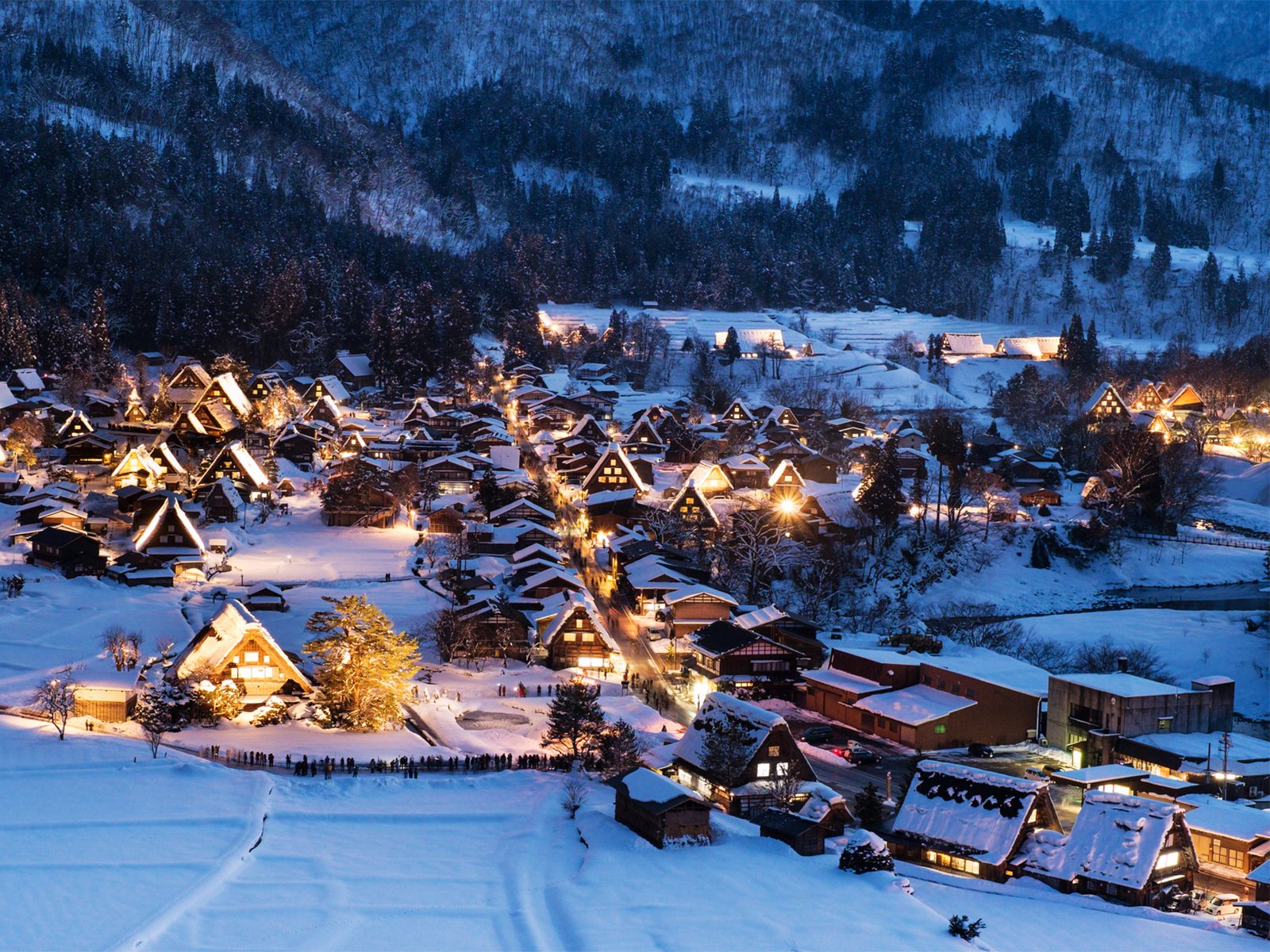A Winter Visit to Shirakawa-go

The mountain village is famous for its rustic charm.
Cover photo: View of snow-covered Shirakawa-go from the Ogimachi Castle Ruins Observation Deck, Gifu Prefecture, Japan (2025). Photo by Danny With Love.
Intro
Nestled in the mountains of central Japan lies the UNESCO World Heritage site Shirakawa-go (白川郷), “Village of the White River.” The rural town is famous for its collection of beautiful farmhouses, which creates an idyllic atmosphere. As many as two million people visit the town every year.
I have grown especially attracted to the town’s images of winter scenery, reminiscent of pastoral paintings by Thomas Kinkade. After three years of living in Japan, I finally made my journey to Shirakawa-go last Sunday, in time for the final night of winter illuminations this season. It was a great trip, featuring beautiful nature, impressive architecture, and delicious food! Please read on for more information about the site and details of my visit.
History
Shirakawa-go is the largest of three towns built on the Sho River valley, collectively designated by UNESCO as the “Historic Villages of Shirakawa-go and Gokayama” in 1995 — thirty years ago!
The name “Shirakawa-go” dates back to the 12th century but little is known about that time. From the Edo era (1603–1868) the village produced silk and gunpowder. Interestingly, unlike most of Japan, it was ruled directly by the Tokugawa shogunate. The historic farmhouses were built in this period.
Architecture
The building style at Shirakawa-go is called gassho-zukuri, translating to “constructed like hands in prayer” in reference to the steep triangular rooftops which loosely resemble hands joined together. This simple, dramatic shape is unusual, thanks largely to the area’s geographic isolation.
Upon his visit in 1935, German architect Bruno Taut lauded, “These buildings present something unique in Japan in so far as their construction is rational and logical throughout.”
Because Shirakawa-go experiences some of the heaviest winters in the nation, every detail was carefully considered. Thatched straw rooftops provide excellent insulation and steep roof angles of about 60 degrees help prevent the buildup of snow. Irori fireplaces keep the structure warm, with smoke drying the roof and preventing rot. The houses are also oriented to face east or west, so as to catch maximum sunlight and minimize wind damage.
Community & Preservation
The thatched roofs should be replaced every 30 years — a labor-intensive task. It can take 150 people and as many as 9,000 bundles of straw to re-thatch a single roof over the course of two days.
Villages rely on a system called yui, or mutual assistance, in which the community gathers together to help their neighbors. It’s also an important opportunity to pass down traditional skills to younger generations.
20th-generation resident Masahito Wada (和田 正人) explains, “the harsh natural environment of Shirakawa-go means that without embracing the ethos of yui, it would be difficult to survive.”
Shirakawa-go’s population peaked in 1960, and the area was declared a preservation district in 1976. Depopulation is a major threat to the site’s longevity. Just 500 people live in Shirakawa-go today, with more than 30% of residents over the age of 65. The village only began to accept outside residents for the traditional farmhouses in 2023.
“I think modern houses are more comfortable to live in,” admits preservation chairman Shinja Noya (野谷 信二), “but we need to protect the gassho-zukuri houses for tourism.”
Experience
I booked my trip with White Ring; the seven-hour tour cost 14,000 yen (approx. 90 USD), including transportation and dinner. It seemed to me a rather expensive package, but it was the only way to guarantee transport and entrance during the illumination event — unfortunately, this tour did not include night-time entrance to the observatory.
We departed from the main station in Kanazawa, with the bus ride taking just over one hour. As winter is peak season, the area was crowded with visitors — mostly Chinese and Filipino tourists. I took some photos for one older woman in exchange for a heartfelt “xièxie” — “thank you.”
The weather was perfect, cloudy but bright. According to our guides, fresh snow had fallen earlier in the week. Once we arrived, I trekked up to the observation deck, offering wide vantage of the site. Together with the steep climb, the stunning view took my breath away. It was truly beautiful, like a wondrous storybook setting, a fairytale village before my eyes.
Descending back into town, I found the rustic charm disrupted by traffic cones and cables crisscrossing the streets in preparation for winter lights. Most buildings housed shops selling ice cream and kitschy souvenirs. I had wanted to explore inside the traditional homes but I was simply unwilling to unlace my boots to enter; I certainly was not prepared to risk wet socks! The temperature was just 7 degrees Celsius (44 Fahrenheit). In daylight, I wondered if I had overdressed, but the thought vanished by nightfall.
My tour group gathered at Hakusuien for dinner at 17:00 (5 PM). To my chagrin, I did have to remove my shoes. Our set meal included river fish, hard tofu, and soba (buckwheat noodles), but the highlight was a small portion of local Hida beef grilled with hoba miso paste atop a dried leaf of magnolia. Combined with mushroom and onion, the taste was delicious! It was certainly memorable, with the fragrant meal lingering on my clothes.
The sun had set by the end of dinner. It was time to enjoy the illuminations. Limited sections of the town were lit by large spotlights, further concentrating the growing crowds. Navigating past patches of ice, flying snowballs, and arms outstretched for selfies, I wandered through the town.
Many streets were completely dark, necessitating the use of flashlights. I could see the dim glow of stars overhead. Underfoot, densely-packed snow was uneven and slippery. Even in my best boots I found it a challenge to maintain my balance!
I strolled through much of the village, concluding with a visit to the “Three Houses” or “Triplets” which are considered a representative view of Shirakawa-go. I was pleased to see them before heading back towards the bus. Craving a warm drink, I stumbled upon a shop serving mulled wine! It was a long journey back. By the time I arrived home around 23:00 (11 PM), I had walked a total 15 kilometers (9.2 miles). I’m excited to visit again in more hospitable weather.
Final Thoughts
As a foreigner living in Japan, I have spent much time thinking about the idea of community. It’s difficult to define, but I think mutual assistance plays a vital role. Ultimately, a community is a group of people willing to help each other. Paradoxically, the ease of modern life has made it more difficult to form real bonds. It’s no surprise that Japan is considered both one of the most convenient and loneliest countries in the world.
A native from Chiba Prefecture, Maiko Fukuda (福田 麻衣子) is one of Shirakawa-go’s newest residents, immigrating ten years ago. She says, “I think the inconvenience of not being able to live alone makes it more human and comfortable, so that’s what’s good about it.”
With any problem, my own first instinct is always to ask Google-sensei for help, but perhaps I should reach out to humans first.





